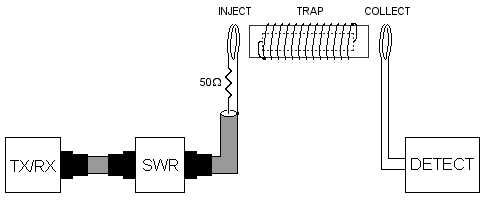|
It has been said that tuning antenna traps requires a grid dip oscillator (GDO). Not so! Using a bit of initiative and some standard equipment a ham should have in the shack makes the job easy. Actually, this may come as a little bit of a shock, I have never owned a GDO. The method shown here has tuned more traps than I care to remember (and not just my own, but traps for many others). And, funny thing, when tested against GDO tuned traps, I found this method to be more accurate.
All that is required is a tuneable, power adjustable transmitter, and either an SWR meter and a decent 50-ohm resistor, or an RF detector of some nature - and this can be anything from an RF probe through to a decent oscilloscope with a reasonable high-frequency capable input (I would reckon at least 60MHz!).
As seen in the above diagram, the trap is suspended in free air (you don't want anything nearby that can change the tuning). The transmitter is coupled to the trap using a couple of turns fed through a 50-ohm resistor (the resistor ensures the transmitter is not 'seeing' a dead short when the trap is not resonating). There are two detection methods. The first is to use an SWR meter. When the trap is resonating, it will present a very high impedance which is indicated by the SWR meter. The second method is using a second coupling coil fed in to some form of an RF indicator - either a good oscilloscope right down to a simple RF probe. Of course, there is nothing saying you cannot use both methods simultaneously!
Couple everything up, and ensure the coupling coils are not too close to the trap as this may affect the resonant frequency. Too far will make detection difficult. Too close will alter the frequency through capacitive coupling (yes, a bit of 'playing' will be needed!). Set the transmitter 'CW' and to the frequency where the trap is desired, and tune up while ensuring the drive is kept very low - just enough to either reflect on the SWR meter or detector and within the power handling capabilities of the resistor. While sweeping through the band, locate the point where the SWR is worst or the detector shows the highest level of signal (or both should both methods be used). This is the trap's resonant frequency. While tuning, some older rigs require the 'drive' portions to be re-tuned so as to keep the drive up (especially if doing this on lower frequency bands and sweeping from edge to edge).
With regards the transmitter, it is almost a case of "the older the better". The real requirement here is that the rig allow the output frequency to be changed while still in transmit mode. Many modern PLL based rigs don't allow one to tune while holding down the PTT. Although there is a lot to be said for modern rigs, they are often based on commercial designs and don't think of a ham's true requirements! The second requirement is the drive must be adjustable. Again, the older rigs tend to have this. Modern rigs seem to operate either in switched powers, or just simply "flat out". Older rigs had "drive" controls allowing adjustment to any desired level of output power. A third desired requirement is the rig must not go in to "shutdown" on bad SWR. Again, the modern rig is designed to 'protect' the output stages by reducing the drive should the antenna show signs of bad mismatch. The problem is they don't shut down on the level of reflected power as a whole, but rather as a ratio of the forward power. So, if you can get past these little hiccups, then all will be well.
© 13.03.05 |
